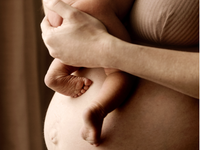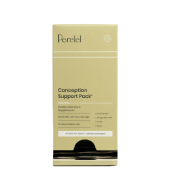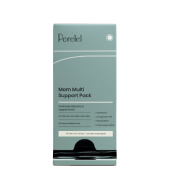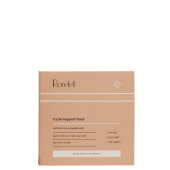While trying to conceive, the two-week wait—that anticipatory time between ovulation and and your expected period—can be anxiety-inducing. It's difficult not to overthink every twinge and symptom as a potential signal for early pregnancy—and that includes some light spotting in the days leading up to menstruation. Could it be implantation bleeding from a pregnancy? Is your period just super-light this month? Or is it something completely unrelated?
Here’s what you need to know about implantation bleeding vs. your period—and how to tell the difference.
What is Implantation Bleeding?
Implantation bleeding may happen when a fertilized egg attaches to the lining of the uterus. This can cause some of the tiny blood vessels in your uterine lining to burst, which can lead to spotting.
This is a relatively common occurrence, affecting up to 25 percent of pregnancies. For some women, it’s the first sign of pregnancy. If you’re one of them, don’t worry—implantation bleeding doesn’t pose a risk to you or your baby.1 And if you’re not one of them? It's not necessarily a bad sign—again, many women don’t experience implantation bleeding.
According to the American Pregnancy Association, you’re most likely to have implantation bleeding during a first pregnancy, when your body is adjusting to the experience—similar to the way your gums bleed more the first time you floss.2
Recognizing implantation bleeding can be a bit tricky because of timing. Ovulation occurs around 14 days before the start of your next period, regardless of your cycle length. Implantation bleeding typically happens 10 to 14 days after ovulation.3 That means the light spotting from implantation bleeding is most likely to happen right around the time your period is due.
How Can You Differentiate Between Implantation Bleeding Vs Your Period?
When you’re trying to conceive and you notice light spotting, you may be wondering whether it’s cause for celebration—or a sign that you need to shift your focus to next month. To make it even more confusing, implantation bleeding (and early pregnancy in general) may cause some symptoms that are similar to PMS symptoms, such as cramps, mood swings, breast tenderness, and lower back pain.
A pregnancy test is the most conclusive way to differentiate between implantation bleeding and your period. Pregnancy tests are most accurate when taken on or after the day your period is due.4
In the meantime, there are a few things5 that can help you determine whether your spotting may be caused by implantation bleeding or your period:
- Cramping. While it’s normal to experience some cramping along with implantation bleeding, these cramps are typically lighter than menstrual cramps.
- Color. Implantation bleeding may be light pink to dark brown in color, while menstrual bleeding is likely to be a redder color.
- Clotting. Some women pass small blood clots during menstruation, whereas implantation bleeding is usually clot-free.
- Amount. Implantation bleeding tends to a pink or brown discharge rather than a full flow. If you’re bleeding enough that you need to change your pad, tampon, or cup, it’s more likely to be your period.
- Length. Implantation bleeding typically doesn’t last more than three full days—and sometimes only lasts for a few hours.
$41.14
First 3 Mo
First 3 Months
$32.90
First 3 Mo
First 3 Months
Shop the Article:


Conception Support Pack*
Shop Now


Fertility+ Support
Shop Now
The Other Possible Explanation: Ovulation Spotting
If you notice spotting much earlier than your period is due, it may be due to ovulation. Ovulation happens around 14 days before the start of your period, and it’s often uneventful—you may not even know you’re ovulating unless you’ve been tracking your cycle closely.
However, some women have light spotting when ovulation occurs. They may also experience ovulation pain, known as mittelschmerz.6 Ovulation spotting is less common than implantation bleeding—research suggests only around 5 percent of women experience midcycle spotting.7
Should You Talk to Your Doctor About Implantation Bleeding?
In most cases, implantation bleeding is nothing to worry about. However, it’s worth noting that light bleeding is sometimes one of the first symptoms of an ectopic pregnancy, which is when the fertilized egg implants outside the uterus, typically in a fallopian tube.
If you’re experiencing any ectopic pregnancy symptoms along with your spotting— such as weakness, dizziness, fainting, nausea, abdominal pain, lower back pain, pelvic pain, rectal pressure, or shoulder pain—let your doctor know ASAP.8 You should also let your doctor know if you experience heavy bleeding, clotting, pelvic pain, or painful cramping.9
Find support with other women who are TTC by joining our community, Village by Perelel on Geneva—and don't forget to follow our step-by-step guide to planning for pregnancy.
References:
- Cleveland Clinic: Implantation Bleeding
- American Pregnancy Association: What is Implantation Bleeding?
- Mayo Clinic: Is implantation bleeding common in early pregnancy?
- Cleveland Clinic: Pregnancy Tests
- American Pregnancy Association: What is Implantation Bleeding?
- Cleveland Clinic: Ovulation
- Sonya S Dasharathy et al; Menstrual Bleeding Patterns Among Regularly Menstruating Women; Mar 2012
- Cleveland Clinic: Ectopic Pregnancy
- Cleveland Clinic: Implantation Bleeding




















